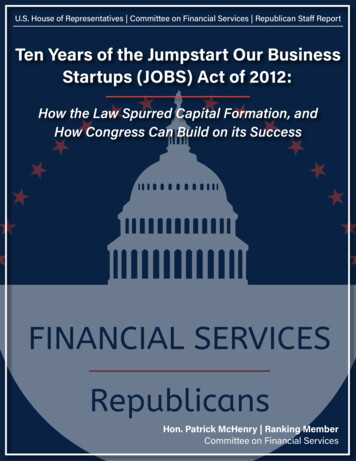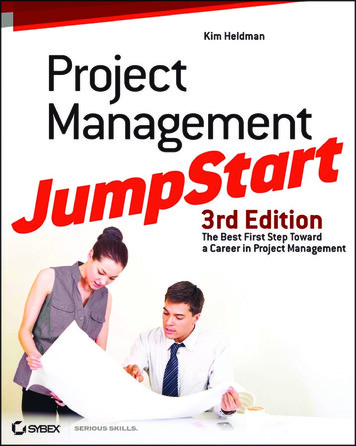
Transcription
U.S. House of Representatives Committee on Financial Services Republican Staff ReportTen Years of the Jumpstart Our BusinessStartups (JOBS) Act of 2012:How the Law Spurred Capital Formation, andHow Congress Can Build on its SuccessHon. Patrick McHenry Ranking MemberCommittee on Financial Services
HOUSE COMMITTEE ON FINANCIAL SERVICESTable of ContentsExecutive Summary2Introduction4Section I. Review of the Jumpstart Our Business Startups (JOBS) Act4Decline in Small Company IPOs and the IPO Task Force4JOBS Act of 20126Title I: Emerging Growth Companies and the IPO “On-Ramp”7Title II: Private Placements7Title III: Crowdfunding9Title IV: Regulation A10Titles V and VI: Thresholds for Mandatory Registration as a Public Company11Title VII: Small Business Outreach11JOBS Act Impacts12The IPO On-Ramp at Work12Raising Capital Under Rule 506(b) and Rule 506(c)19Impacts of New Regulation A23Crowdfunding27SEC Harmonizes Exempt Offerings Framework27Section II. Building on the JOBS Act’s Success29The Need for Congressional Action29Strengthening U.S. Public Markets31Expanding Opportunities for Underrepresented Entrepreneurs and Investors35Additional Policies to Consider41REPUBLICAN STAFF REPORT1
Executive SummaryTen years ago, a divided Congress came together to pass bipartisan legislation to helpsmall businesses access capital. The bipartisan Jumpstart Our Business Startups Act, or JOBSAct of 2012, reduced regulatory barriers and created new avenues within our securities laws tofacilitate capital formation for small businesses. On April 5, 2012, President Obama signed theJOBS Act into law.JOBS Act of 2012The JOBS Act consisted of six bills, each intended to ease the capital formation processfor small companies and entrepreneurs attempting to raise funds through U.S. capital markets. Toencourage more small-cap IPOs, Title I created a new “Emerging Growth Company” (EGC)designation and an IPO “on ramp” for companies to gradually begin complying with publiccompany regulatory requirements. Title II eased the process by which startups market theirsecurities by extending the Rule 506 offering exemption to securities marketed through a generalsolicitation or advertising if the purchaser is an accredited investor. Title III allowed startups toraise funds through a new equity crowdfunding exemption. Title IV required the SEC to add aclass of securities that would be exempt from registration for offerings up to 50 million. TitlesV and VI raised the thresholds for mandatory registration as a public company so privatecompanies would not be forced to go public until they were ready.JOBS Act ImpactsBecause Title I was self-effectuating, small companies utilized the IPO on-rampimmediately. The IPO on-ramp’s compliance accommodations made a significant difference inattracting young, high-growth companies to raise capital in American public markets. While thenew exemptions from Titles II-IV cannot boast similarly outstanding results as Title I, they arestill helping small companies and entrepreneurs raise the capital necessary for growing andhiring more workers. The number of offerings and the capital raised each year under these newexemptions has mostly climbed year-over-year since the SEC implemented the respective rules.Need for Congressional ActionAmerican capital markets are stronger now than they were ten years ago. Because of theJOBS Act, entrepreneurs can raise capital more easily. However, unnecessary and costlyregulatory burdens continue to keep businesses and entrepreneurs from growing, hurting theUnited States’ competitiveness both at home and abroad. While Americans have started newbusinesses at record rates since the COVID-19 pandemic, they still struggle to meet their capitalneeds. Until 2020, the number of U.S. IPOs hovered around half the number of domestic IPOs 20years ago, as the costs and regulatory burdens of going public remain high. Additionally, foreignmarkets like China continue to grow, increasing the urgency with which Congress must act toprotect and build on successes of the JOBS Act.Today’s political environment is similar to that of 2012. Yet, ten years ago, a dividedWashington proved it could come together to support America’s entrepreneurs and job creators2
to strengthen U.S. capital markets and economic activity. It is time Washington harness thatsame conviction.Strengthening U.S. Public MarketsTo encourage more companies to go public in the U.S., Congress should consideradditional reforms that build on the successes of Title I of the JOBS Act. This includes extendingthe IPO on-ramp; expanding well-known seasoned issuer (WKSI) eligibility and its advantageslike automatic shelf registration to more companies; streamlining and clarifying the EGC publicfiling condition; updating the IPO on-ramp to include spin-off transactions; clarifying EGCfinancial statement obligations to prevent aberrational results; permitting the auditor of a privatecompany transitioning to public company status to comply with SEC and PCAOB independencerules; expanding protection for research reports to cover all securities of all issuers; andexcluding qualified institutional buyers (QIBs) and institutional accredited investors from therecord holder count for mandatory Exchange Act registration.Expanding Opportunities for Underrepresented Entrepreneurs and InvestorsCongress should also do more to enhance the ways in which companies raise capitalthrough our private markets. To that end, Congress should increase investment opportunities foreveryday American investors in our private markets as more high-growth companies seek toraise capital privately. This includes making our capital markets inclusive for all entrepreneursand investors of all backgrounds: modernizing the accredited investor definition; increasingaccess to investment opportunities for retail investors through closed-end funds; modify thequalifying venture capital fund exemption under Section 3(c)(1) of the Investment Company Actof 1940; expanding the scope of qualifying investments for venture capital funds; and creating amicro-offering exemption.3
Ten Years of the Jumpstart Our Business Startups (JOBS) Act of 2012: Howthe Law Spurred Capital Formation, and How Congress Can Build on itsSuccessIntroductionTen years ago, a divided Congress passed legislation that modernized and pared backlaws and regulations in a widely bipartisan effort to help small businesses access capital. Thislegislation, the Jumpstart Our Business Startups Act, or JOBS Act of 2012, reduced regulatorybarriers and created new avenues within our securities laws to facilitate capital formation forsmall businesses. On April 5, 2012, President Obama signed the JOBS Act into law.This report reviews the problems the JOBS Act intended to address, discusses theeffectiveness of the legislation’s provisions after ten years of its enactment, and profiles severalcompanies that relied on the JOBS Act to raise capital that was critical to their growth, success,and job creation.The report also considers ways in which Congress can build on the success of the JOBSAct by further modernizing our securities laws to empower both job creators and investors—particularly underrepresented entrepreneurs and investors. Like ten years ago, it is time toremove unnecessary barriers to capital-raising and make our securities laws more inclusive forentrepreneurs and investors pursuing the American dream.Section I. Review of the Jumpstart Our Business Startups (JOBS) ActA. Decline in Small Company IPOs and the IPO Task ForceThroughout most of the Twentieth Century, the majority of young American companieswith high-growth potential and innovative products turned to our public markets for their capitalneeds.1 At a time when the markets and regulatory environment were more conducive to smalland mid-capitalization stocks, groundbreaking American companies like Apple, Cisco, FedEx,and Starbucks raised capital by going public through small-cap offerings.2 Through an initialpublic offering (IPO), these upstart enterprises raised the funding necessary to expand theirworkforce and operations. Simultaneously, everyday retail investors benefited from theopportunity to buy into high-growth companies to diversify their holdings and build their nestegg.In October 2011, President Obama’s IPO Task Force (the “Task Force”) published areport detailing troubling trends for smaller companies in our capital markets.3 The Task Forcefound that, from 1996 to 2011, American capital markets witnessed a steep decline in the number1IPO Task Force, Rebuilding the IPO On-Ramp: Putting Emerging Companies and the Job Market Back on theRoad to Growth (the “IPO Task Force Report”) (Oct. 20, 2011), available ng the ipo on-ramp.pdf.2Id. at 5.3Id.4
of IPOs of what are now known as emerging growth companies (EGCs)—that is, companieswith less than 1 billion in annual revenue. After achieving an all-time yearly high of 791 IPOsin 1996, the U.S. capital markets averaged fewer than 157 IPOs per year from 2001 to 2008.4Prior to 1999, the U.S. averaged 547 IPOs per year (see Figure 1).5 Additionally, the Task Forceobserved that those companies going public in the years leading up to its report were doing so ata later stage in the company life cycle. From 1997 to 2001, the average age of a company at thetime of its IPO was around five and a half years, while the average IPO company age between2006 and 2011 was over nine years.6Figure 1: IPOs Were Down, Particularly Smaller IPOs7In addition to the concerns over the attractiveness and competitiveness of our capitalmarkets, this significant downturn was troubling given the importance of these small-cap publiccompanies in American job creation. The Task Force report noted the importance of post-IPOjob growth, as shown in the graphic below.4Id. at 6.Id.6Id.7Id. at 2.55
Figure 2: IPOs Finance Significant Job Creation8In explaining the causes for the decline in small company IPOs from 1996 to 2011, theTask Force pointed to an accumulation of regulatory and market structure changes. Thesechanges drove up costs for emerging growth companies interested in going public and limited theamount of information available to investors about these companies.9To counter these harmful effects on small-cap IPOs, the IPO Task Force Report includeda series of recommendations. These recommendations were intended to modernize “the scale ofcurrent regulations without changing their spirit.”10B. JOBS Act of 2012Following the release of the IPO Task Force Report in October 2011, Congressincorporated several of the Task Force’s recommendations into the JOBS Act of 2012.11 Signedinto law by President Obama on April 5, 2012, the JOBS Act combines six separate bills thatoriginated in the House Financial Services Committee. The bills were intended to help smallcompanies obtain access to U.S. capital markets by right-sizing the burden of certain securitiesregulations for smaller companies. The JOBS Act pushed the Securities and ExchangeCommission (SEC) to rethink its traditional approach to securities regulation. As noted byformer SEC Commissioner Mike Piwowar:“The JOBS Act requires the Commission to think of capital formation and investorprotection in fundamentally different ways than we have in the past. The crowdfundingprovision of the JOBS Act forces us to think outside of our historical securities regulationbox and to create a different paradigm than the one we have used for the past eightdecades.”128Id. at 1.Id. at 210Id. at 3.11Jumpstart Our Business Startups (JOBS) Act of 2012, Pub. L. No. 112-106, 126 Stat. 306 (2012).12SEC Commissioner Michael S. Piwowar, Statement at Open Meeting Regarding Crowdfunding (Oct. 23, 2013),available at tmt/1370542558708.96
Jonah Crane, former Counsel to Senator Charles Schumer (D-NY) when the bill wasbeing negotiated and during its passage, reflected on the origins of the JOBS Act, stating:“The JOBS Act came together due to some unique circumstances: A sense that theeconomic recovery was lagging a bit, so proposals that might plausibly support jobgrowth were in demand. Partisan tensions had been escalating, and there was a strongdesire on the part of many in Congress to pass bipartisan legislation. And along came theJOBS Act, a series of proposals, each with bipartisan support, packaged together byleaders in the House and labeled the ‘JOBS Act.’ So despite the fact—or perhapsbecause—it was an election year, a large bipartisan group of Senators and Members ofCongress opted for common sense.”13Title I: Emerging Growth Companies and the IPO “On-Ramp”Title I of the JOBS Act established a new category of issuers known as “EmergingGrowth Companies” (EGCs). These issuers must have less than 1.07 billion in annual revenuesor 700 million in public float when they register with the SEC.14 These companies are given an“on ramp” of up to five years to comply with certain regulatory requirements prior to,throughout, and immediately after the company’s IPO.15 Title I allows EGCs the ability to pitcha contemplated IPO to institutional investors before filing a registration statement with the SEC(known as “testing the waters”); initiate the SEC IPO registration process confidentially; gopublic with scaled financial disclosure requirements; and the option to abstain from SarbanesOxley internal control audits and Dodd-Frank executive compensation disclosures.16Additionally, Title I authorized research analysts at the underwriter to publish research coverageand reports directly following the earnings release, as opposed to waiting a precise number ofdays.17 By granting these issuers a temporary “on-ramp” status, Title I encourages smallcompanies to go public while ensuring that they graduate to full regulatory compliance as theygrow large enough to sustain the compliance infrastructure typical of mature companies.Title II: Private Placements13Interview by McArn Bennett with Jonah Crane, Former Counsel to Sen. Charles Schumer (D-NY) 2009-13(March 2, 2022).14JOBS Act §§ 101-108. The JOBS Act Title I text specified an annual revenue cap of 1 billion but also requiredthe SEC to index the cap to inflation every five years. As such, in 2017, the SEC updated the annual revenue cap to 1.07 billion. See “Inflation Adjustments and Other Technical Amendments Under Titles I and III of the JOBS Act,”Release No. 33-10332, File No. S7-09-16 (April 5, 2017), available at 5JOBS Act § 101 (adding new Section 2(a)(19) of the Securities Act of 1933 and Section 3(a)(80) of the SecuritiesExchange Act of 1934). After the initial determination of EGC status, a company will remain an EGC until theearliest of: the last day of any fiscal year in which the company earns 1.0 billion or more in revenue; the date when the company qualifies as a “large accelerated filer,” with at least 700 million in publicequity float; the last day of the fiscal year ending after the fifth anniversary of the IPO pricing date; or the date of issuance, in any three-year period, of more than 1.0 billion in non-convertible debt securities.16JOBS Act §§ 102-107.17JOBS Act § 105.7
Title II of the JOBS Act made it easier for startups to market their securities through ageneral solicitation or advertising. The Securities Act of 1933 (“the Securities Act”) requires thatoffers to sell securities must either be registered with the SEC or specifically exempted fromsuch registration. A company or issuer that fully registers with the SEC may sell its securities tothe public and the purchasers of those securities may sell them in the secondary market withoutrestriction.However, full registration associated with going public and remaining a public companyresults in increased compliance costs. Prior to an IPO, companies often spend tens of millions ofdollars gathering and compiling mandatory specified information to submit to the SEC and makeavailable to the public for the sale of its securities.18 After its IPO, the company must continue tocomply with SEC regulatory requirements, such as audit requirements and disclosurerequirements intended to provide investors and potential investors information necessary to makeinformed investment decisions.Many companies want to avoid the costs associated with being a publicly tradedcompany, especially smaller companies. The exemptions from the Securities Act registrationrequirements provide an attractive path to raising capital through the sale of its securities. Onesuch exemption from the Securities Act registration requirements is Rule 506 of Regulation D.Reg D allows companies to offer securities for sale in a private placement or offering if they donot market their securities through general solicitations or advertising.19Title II of the JOBS Act extended this exemption for private placements to securitiesmarketed through a general solicitation or advertising so long as the issuer verifies thatpurchasers of the securities are “accredited investors.”20 Accredited investors are defined asinstitutional investors or individual investors who meet specific income or net worth tests.Additionally, Title II directed the SEC to update Rule 144A. Rule 144A is a safe harborexemption that permits the offering of unregistered securities in the secondary market—with noholding period requirement—to qualified institutional buyers (“QIBs”). QIBs are generallyinstitutional investors and dealers who own and invest on a discretionary basis a minimum of 100 million and 10 million, respectively.21 Specifically, Title II instructed the SEC to updateRule 144A to allow securities sold under the revised Rule 506 exemption to be offered to nonQIBs. This permits private placements and securities sold through private placements to beoffered—practically speaking, advertised—through any means or medium.2218Thaya Brook Knight, A Walk Through the JOBS Act of 2012: Deregulation in the Wake of Financial Crisis, CatoInstitute (May 3, 2016), at 9, available at 17 C.F.R. § 230.506.20JOBS Act § 201(a).2117 C.F.R. § 230.144A(a).22JOBS Act § 201. See also Thaya Brook Knight, supra note 18, at 13.8
The SEC adopted the final rules implementing the updates required by Title II in 2013,incorporating two variations of Rule 506 offerings.23 First, the final rule retained the traditionalRule 506 offering, now named a “506(b)” offering, prohibiting general solicitations and limitingthe number of non-accredited investors.24 The other type of offering included in the final ruleincluded a Rule 506(c) offering, allows for general solicitation but restricts issuing companies tosell only to accredited investors.25Title III: CrowdfundingTitle III of the JOBS Act enabled startups to raise capital through crowdfunding. At thetime, crowdfunding was a new and innovative way for startups and small businesses to raisecapital, typically over the Internet. Entities or individuals that raise funds through crowdfundingtypically seek small contributions from a large number of people. Crowdfunding campaignsgenerally specify a target amount to be raised and identify the purpose for which those funds willbe used. Title III exempted securities issued through crowdfunding from SEC registrationrequirements.26 To qualify for this exemption, an issuer’s offering may not exceed 5 million.27A non-accredited investor whose income or net worth is below 107,000 may invest up to either 2,200 or 5 percent of the investor’s annual income or net worth, whichever is greater.28 A nonaccredited investor whose income and net worth are equal to or greater than 107,000 may investup to 107,000 or 10 percent of the investor’s annual income or net worth, whichever isgreater.29 These offerings must be conducted through an intermediary, who must register withthe SEC as either a broker-dealer or a funding portal.30Title III of the JOBS Act directed the SEC to issue rules implementing the crowdfundingprovisions by January 2013. The SEC missed this deadline. In October 2015, the SEC finallycompleted its Title III rulemaking by adopting Regulation Crowdfunding.31 When the SEC23See SEC Press Release 2013-124, SEC Approves JOBS Act Requirement to Lift General Solicitation Ban (July 13,2013) available at 24See “Eliminating the Prohibition Against General Solicitation and General Advertising in Rule 506 and Rule144A Offerings,” Release No. 33-9415; File No. S7-07-12 (July 13, 2021), available .25Id.26JOBS Act § 302.27The JOBS Act Title III text specified an offering limit of 1 million but also required the SEC to index theoffering limit to inflation every five years. As such, in April 2017, the SEC updated the offering limit to 1.07million. See “Inflation Adjustments and Other Technical Amendments Under Titles I and III of the JOBS Act,”Release No. 33-10332, File No. S7-09-16 (April 5, 2017), available at https://www.sec.gov/rules/final/2017/3310332.pdf. In 2020, the SEC adopted amendments raising the offering limit to 5 million and adjusting certaininvestment limits, notably eliminating the investment limit for accredited investors. See SEC Press Release 2020273, SEC Harmonizes and Improves “Patchwork” Exempt Offering Framework (Nov. 2, 2020), available 2817 C.F.R. § 227.100(a)(2)(i).2917 C.F.R. § 227.100(a)(2)(ii).30JOBS Act § 302.31See SEC Press Release 2015-249, SEC Adopts Rules to Permit Crowdfunding (Oct. 30, 2015) available tml. See “Crowdfunding,” Release Nos. 33-9974; 34-76324; FileNo. S7-09-13 (Oct. 30, 2015), available at https://www.sec.gov/rules/final/2015/33-9974.pdf.9
adopted its final rules, Republican SEC Commissioner Michael Piwowar dissented. In hisdissenting statement, he noted several important issues and concerns:While crowdfunding was intended to be a treat for the smallest and least sophisticatedcompanies seeking to raise capital, today’s rules are full of tricks. The rules will spin acomplex web of provisions and requirements for compliance. I fear that many traps forthe unwary are hidden in the regulations, creating potential nightmares for small businessowners that fail to place regulatory compliance at the top of their business plans. Suchburdens will spook many small businesses from pursuing crowdfunding as a viable pathto raising capital .[T]he Commission has exercised discretion to make capital raising using crowdfundingeven more difficult . Because the majority of the Commission cannot trust ordinaryAmericans—the non-accredited investors—to be able to exercise appropriate judgment inhow to spend or invest their resources, our rules will now place smaller limits on theamounts that can be invested. Rather than actually protecting investors, these smallerlimits will discourage legitimate companies from engaging in crowdfunding .32Title IV: Regulation ATitle IV directed the SEC to adopt rules to add a class of securities that would be exemptfrom the Securities Act registration requirements for offerings of securities of up to 50 millionwithin a twelve-month period.33 These rules, commonly referred to as Regulation A , increasedthe number of small companies that can access the capital markets under the existing RegulationA’s registration exemption available only to offerings under 5 million. Title IV also requiredthe SEC to review and increase the new 50 million offering threshold within two years ofenactment and every two years thereafter. Decisions to keep the offering threshold at existinglevels must be reported to Congress.34In March 2015, the SEC approved the final rule to implement Title IV of the JOBS Act.35The final rule provided for two tiers of Regulation A offerings: Tier 1, for offerings of securitiesof up to 20 million in a 12-month period, with not more than 6 million in offers by sellingsecurity-holders that are affiliates of the issuer; and Tier 2, for offerings of securities of up to 50million in a 12-month period, with not more than 15 million in offers by selling security-holdersthat are affiliates of the issuer.36 Both tiers are subject to certain basic requirements while Tier 2offerings are also subject to additional disclosure and ongoing reporting requirements.37 Thefinal rule also provided for the preemption of state securities law registration and qualification32See Commissioner Michael Piwowar, Dissenting Statement at Open Meeting on Crowdfunding and SmallBusiness Capital Formation (Oct. 30, 2015), available at ioncrowdfunding-147-504.html.33JOBS Act § 401.34Id.35See SEC Press Release 2015-49, SEC Adopts Rules to Facilitate Smaller Companies’ Access to Capital (March25, 2015), available at 36Id.37Id.10
requirements for securities offered or sold to “qualified purchasers” in Tier 2 offerings.38 In2020, the SEC adopted amendments raising the offering cap for Tier 2 offerings from 50million to 75 million and raised the offering cap for secondary sales under Tier 2 from 15million to 22.5 million.39Titles V and VI: Thresholds for Mandatory Registration as a Public CompanyTitle V raised the thresholds for mandatory registration under the Securities ExchangeAct of 1934 (“the Exchange Act”) from 1 million in total assets to 10 million and from 500shareholders to 2,000 shareholders for all companies, of which a maximum of 500 can be nonaccredited investors.40 Title V provided that persons who received securities under employeecompensation plans will not be counted against the shareholder threshold cap.41 Title V alsorequired the SEC to revise the definition of “held of record” and to adopt safe harbor provisionsthat issuers can rely on in determining whether holders of their securities received thosesecurities under an employee compensation plan.42 Additionally, Title V required the SEC tostudy whether it has adequate authority to enforce the anti-evasion provisions associated with theshareholder threshold.43Title VI raised the Exchange Act registration threshold from 500 to 2,000 record holdersof equity securities for banks or bank holding companies with total assets over 10 million.44Title VI also raised the threshold for deregistration for banks and bank holding companies from300 to 1,200 shareholders.45 Additionally, it required the SEC to issue final regulations toimplement the amendments made by Title VI no later than one year after the date of enactment.46Title VII: Small Business OutreachTitle VII required the SEC to provide online information and conduct outreach to informsmall and medium-sized businesses, women-owned businesses, veteran-owned businesses, andminority-owned businesses of the changes made by the JOBS Act.47 To meet this requirement,the SEC partnered with the Small Business Administration to inform the public about the newoptions for raising capital established by the JOBS Act.4838Id.See SEC Press Release 2020-273, supra note 27.40JOBS Act § 501.41JOBS Act § 502.42JOBS Act § 503.43JOBS Act § 504.44JOBS Act § 601.45Id.46Id.47JOBS Act § 701.48See SEC Press Release 2014-196, SEC and SBA to Partner on Events on Small Business Capital Raising Underthe Jumpstart Our Business Startups (JOBS) Act (Sept. 16, 2014), available ssRelease/1370542964443.3911
C. JOBS Act ImpactsThe IPO On-Ramp at WorkUnlike many other provisions in the JOBS Act, Title I’s changes to securities law wereself-effectuating. The ability of companies to classify as EGCs immediately after enactmenttranslated to prompt and noticeable impacts in American IPO trends.Within one year of enactment, just under 75 percent of companies that priced an IPO inthe U.S. were designated as EGCs.49 Of those EGCs that publicly filed their first registrationstatement in the first year following enactment, over 90 percent of them utilized at least one ofthe scaled regulatory requirements provided by the JOBS Act.50 Title I’s confidential filingaccommodation was particularly popular among EGCs in the law’s first year. In that first year,roughly 65 percent of EGCs that publicly filed their initial registration statement after April 5,2012, confidentially filed at least one draft registration statement before publicly filing.51Likewise, almost all EGCs that priced an IPO in the first year after enactment signaled theirintent to utilize the delayed phase-in of the internal controls audit requirement.52 Moreover,issuers disclosing their EGC status became standard practice within that first year.53The popularity and usage of EGC status and the IPO on-ramp continued to increase afterthe first year. By April 2014, EGCs represented roughly 85 percent of all IPOs in U.S. capitalmarkets, up from 75 percent a year earlier (see Table 1).54 In the second year followingenactment, confidential filing had become a nearly universal practice, with around 90 percent ofEGCs that priced an IPO in that second year confidentially filing at least one draft registrationstatement before publicly filing.55 Other Title I accommodations increased in popularity,including “testing the waters.” For industries like life sciences, issuers reported testing the watersin almost every deal.56 Within those first two years after enactment, the JOBS Act changed howcompanies went public, and the evidence indicated that Title I’s IPO on-ramp was functioning asdesigned. In 2014, one group of researchers estimated that “the JOBS Act has led to 21additional IPOs annually, a 25 percent increase over pre-JOBS levels.”5749Latham & Watkins LLP, The JOBS Act After One Year: A Review of
2 Executive Summary Ten years ago, a divided Congress came together to pass bipartisan legislation to help small businesses access capital. The bipartisan Jumpstart Our Business Startups Act, or JOBS Act of 2012, reduced regulatory barriers and created new avenues within our securities laws to










